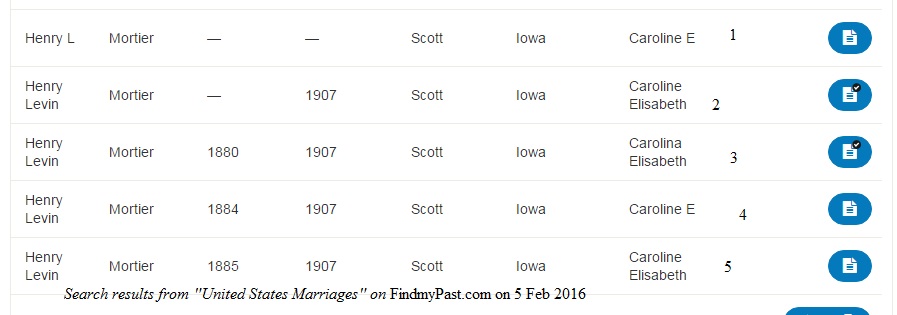Our earlier post on the United States marriage records at FindMyPast touched on the issue of citing those database entries. It was decided to put that discussion in a separate post.
It must be said first that the “United States Marriages” database at FindMyPast is derivative in nature. That’s not bad, but researchers are advised to view images of records where possible. The citations included below are done in the spirit of Evidence Explained combined with my attempt to include sufficient detail without being repetitive.
Let it be said that I’m not a huge fan of this database in the first place. The only time I would actually cite a marriage entry from this database is:
- I could not find an entry for the marriage in any other index or finding aid.
- And….For some reason (other than laziness) I was unable to view the image of the actual record.
If I get myself to the actual image of the actual record, then that’s what I cite. And I don’t need to cite the index–unless it includes relevant additional information. To be honest most of the statewide or national indexes don’t include any relevant information that’s not on the actual record. Local indexes created by local clerks are an occasional exception to the “index does’t add anything rule.”
The citation should get me to the specific entry in the database. Instead of including search terms in the citation, I have opted to include as many details from the “search results” screen as possible so that someone using the citation will be able to click on the appropriate entry.
Using Evidence Explained as my guide, I came up with this general template:
“United States Marriages,” database, FindMyPast.com (http://www.findmypast.com : accessed 6 February 2016), enough details from the index entry so that someone else knows precisely what entry to which you are referring; citing FHL microfilm XXXXXXXX.
My method behind the “include enough details from the index entry so that someone else knows precisely what entry to which you are referring” is so that you won’t have to guess which of the multiple entries for the same couple to which you are referring. And there will be multiple entries for the same marriage.
Each marriage’s entry contains the Family History Library microfilm roll number from which the data was obtained. That’s what should be in your “citing” part. I’ve opted not to go to FHL roll numbers to see what is on the roll. That’s because each roll number does not necessarily send me to a specific record. Or it may simply be laziness.
That said, we’ll cite the five, yes that’s right–five–marriage database entries for Henry and Caroline (Freund) Mortier from Davenport, Iowa. These database entries are not linked to actual images of records.
- “United States Marriages,” database, FindMyPast.com (http://www.findmypast.com : accessed 6 February 2016), Henry L.Mortier and Caroline E. in Scott County, Iowa, no date; citing FHL microfilm 002030636.
- “United States Marriages,” database, FindMyPast.com (http://www.findmypast.com : accessed 6 February 2016), Henry Levin Mortier and Caroline Elisabeth in Scott County, Iowa, 1907; citing FHL microfilm 002030636.
- “United States Marriages,” database, FindMyPast.com (http://www.findmypast.com : accessed 6 February 2016), Henry Levin Mortier and Carolina Elisabeth in Scott County, Iowa, 1907; citing FHL microfilm 001432216.
- “United States Marriages,” database, FindMyPast.com (http://www.findmypast.com : accessed 6 February 2016), Henry Levin Mortier and Caroline E. in Scott County, Iowa, 1907; citing FHL microfilm 002030636.
- “United States Marriages,” database, FindMyPast.com (http://www.findmypast.com : accessed 6 February 2016), Henry Levin Mortier and Caroline Elisabeth in Scott County, Iowa, 1907; citing FHL microfilm 1004424.
That said, I would really prefer to use the actual records from which these index entries were created. Readers are reminded that these marriage records are available on FamilySearch as separate databases for each state, many linked to actual images. That would be the preferred research approach instead of only using these transcribed index references.
The images of the original records may indicate that the transcription was incorrect or that there was additional untranscribed information.


No responses yet